1993 CHEVROLET ASTRO PASSENGER brake fluid
[x] Cancel search: brake fluidPage 245 of 345
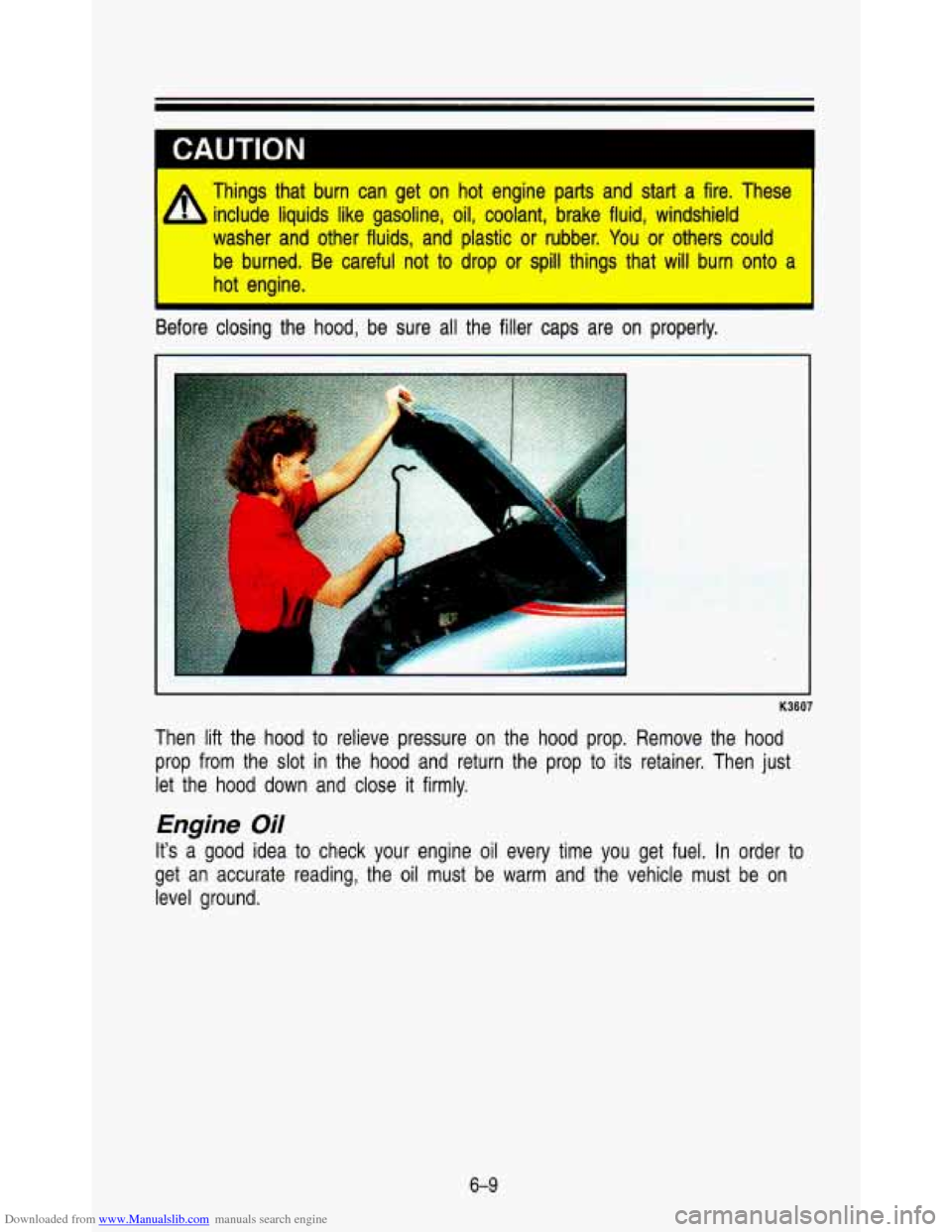
Downloaded from www.Manualslib.com manuals search engine A
Things that burn can get on hot engine parts and start a fire. These
include liquids like gasoline, oil, coolant, brake fluid, windsh\
ield
washer and other fluids, and plastic or rubber. You or others could
be burned. Be careful not to drop or spill things that will burn onto a
hot engine.
I I
Before closing the hood, be sure all the filler caps are on properly.
I
~
K3607
Then lift the hood to relieve pressure on the hood prop. Remove the hood
prop from the slot in the hood and return the prop to its retainer. Then just
let the hood down and close
it firmly.
Engine Oil
It’s a good idea to check your engine oil every time you get fuel. In order to
get an accurate reading, the oil must be warm and the vehicle\
must be on level ground.
6-9
Page 257 of 345
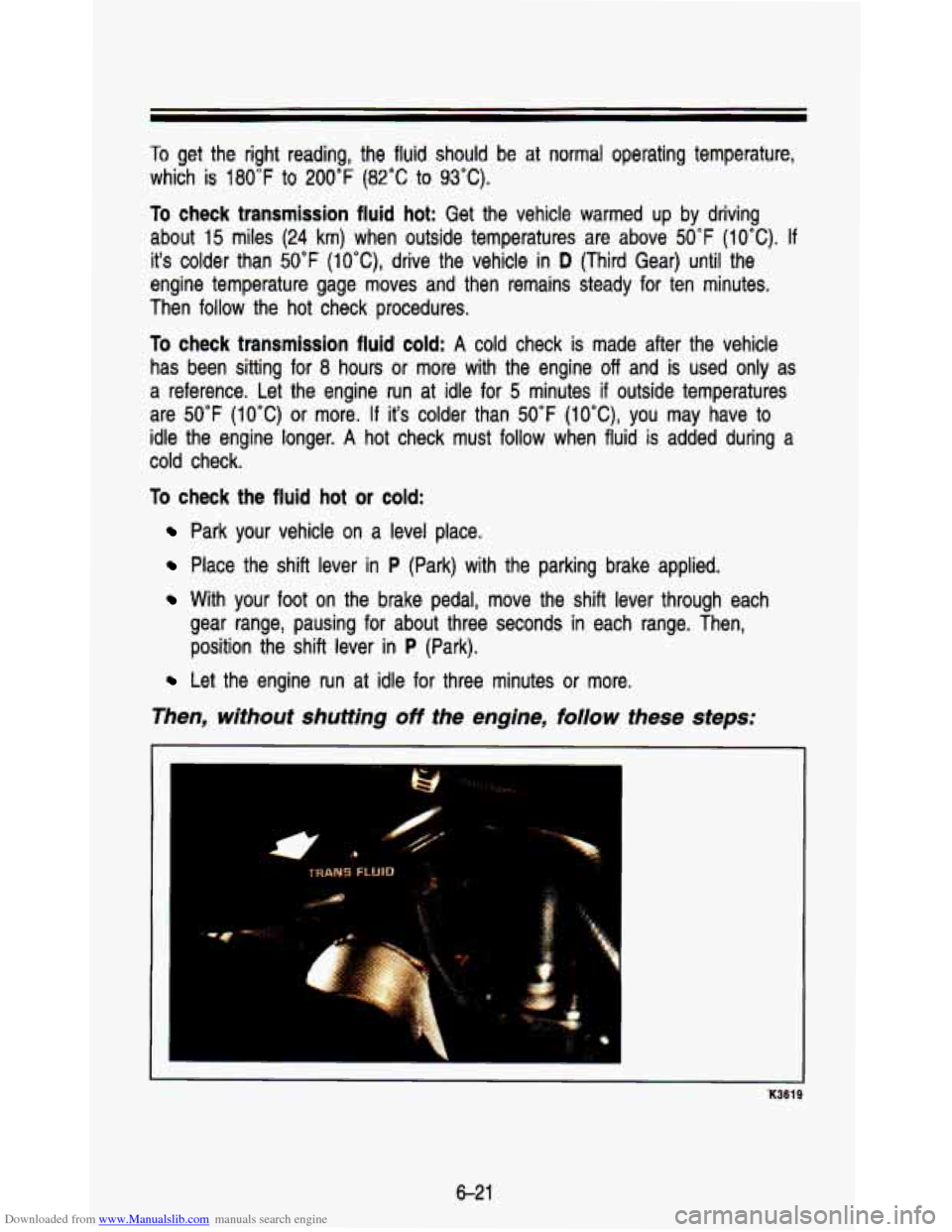
Downloaded from www.Manualslib.com manuals search engine To get the right reading, the fluid should be at normal operating temperature,
which is
180°F to 200°F (82°C to 93°C).
To check transmission fluid hot: Get the vehicle warmed up by driving
about
15 miles (24 km) when outside temperatures are above 50°F (10°C). If
it's colder than 50°F (lO'C), drive the vehicle in D (Third Gear) until the
engine temperature gage moves and then remains steady for ten \
minutes.
Then follow the hot check procedures.
To check transmission fluid cold: A cold check is made after the vehicle
has been sitting for
8 hours or more with the engine off and is used only as
a reference. Let the engine run at idle for
5 minutes if outside temperatures
are
50°F (1 0°C) or more. If it's colder than 50°F (lO"C), you may have to
idle the engine longer.
A hot check must follow when fluid is added during a
cold check.
To check the fluid hot or cold:
Park your vehicle on a level place.
Place the shift lever in P (Park) with the parking brake applied.
With your foot on the brake pedal, move the shift lever throu\
gh each
gear range, pausing for about three seconds in each range. Then,
position the shift lever in
P (Park).
Let the engine run at idle for three minutes or more.
Then, without shutting off the engine, follow these steps:
K3619
6-21
Page 268 of 345
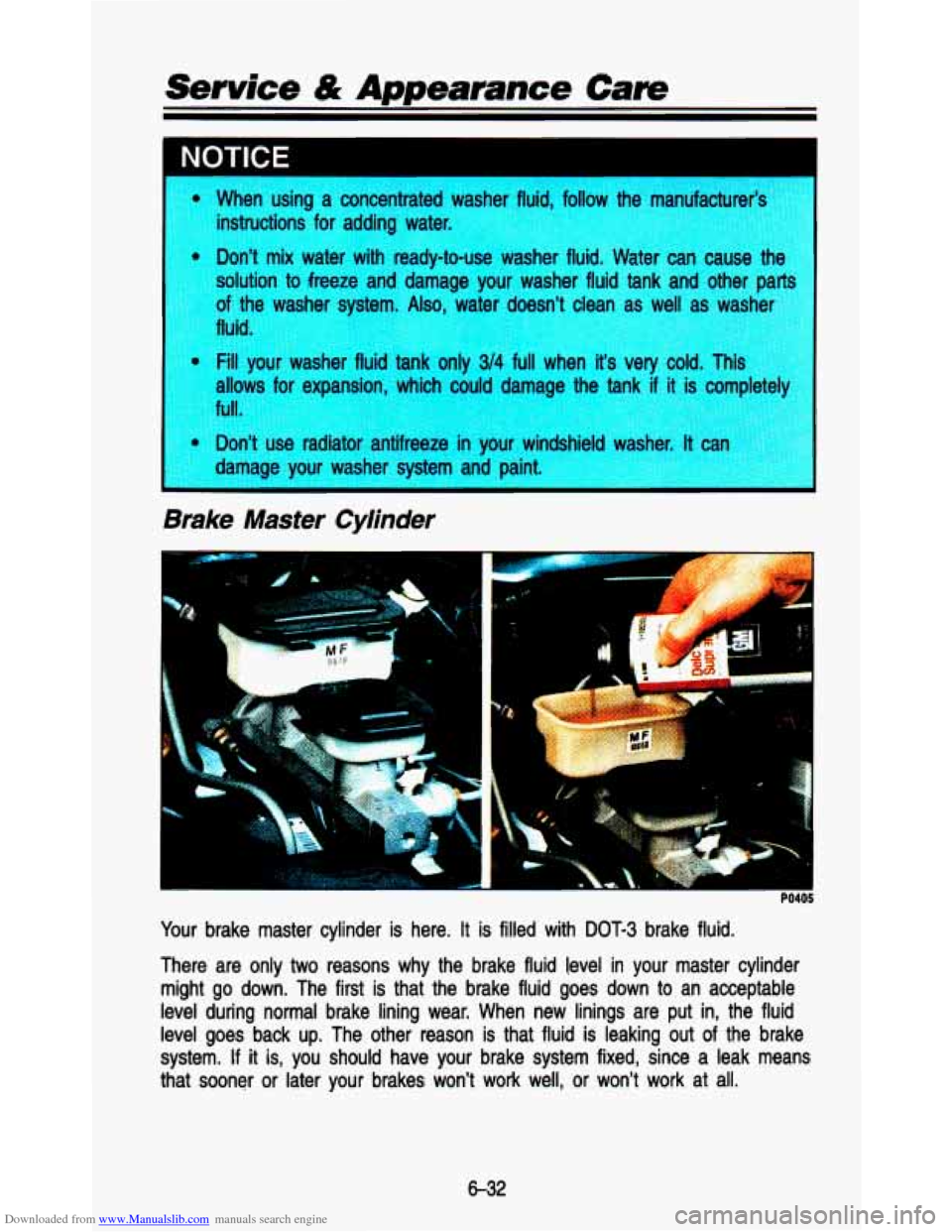
Downloaded from www.Manualslib.com manuals search engine Service & Appearance Care
0
I.
I
When using a concentrated washer fluid, follow the manufacturer'\
s instructions for adding water.
Don't mix water with ready-to-use washer fluid. Water can cause\
the
solution
to freeze and damage your washer fluid tank and other parts
of the washer system. Also, water doesn't clean as well as washer\
I
fluid.
Fill your washer fluid tank only 314 full"when it's'vety cold. This
allows for expansion, which could damage the tank
if it is completely I
full.
"L..:.i: , , I_ y:~ i; P .. .. . . .. . .... . *>,: " 2 ..., .- .. .. ;'r : ,y*: , '-I 1' .:a,' ...j , .I' _I .~ ,.., <:':,.YY<..'.% , , .', < .. c7~ Ij
" .,. , , ...j. .. :,,;,.: >: :,:. I, ~,~. .,. ._
Don't use radiator antifreeze in your windshield washer. It can
damage your washer system and paint.
I
Brake Master Cylhder
Your brake master cylinder is here. It is filled with DOT-3 brake fluid.
There are only
two reasons why the brake fluid level in your master cylinder
might go down. The first is that the brake fluid goes down to an acceptable
level during normal brake lining wear. When new linings are put in, the fluid
level goes back up. The other reason is that fluid is leaking out of the brake
system.
If it is, you should have your brake system fixed, since a leak mea\
ns
that sooner or later your brakes won't work well, or won't wo\
rk at all.
6-32
Page 269 of 345
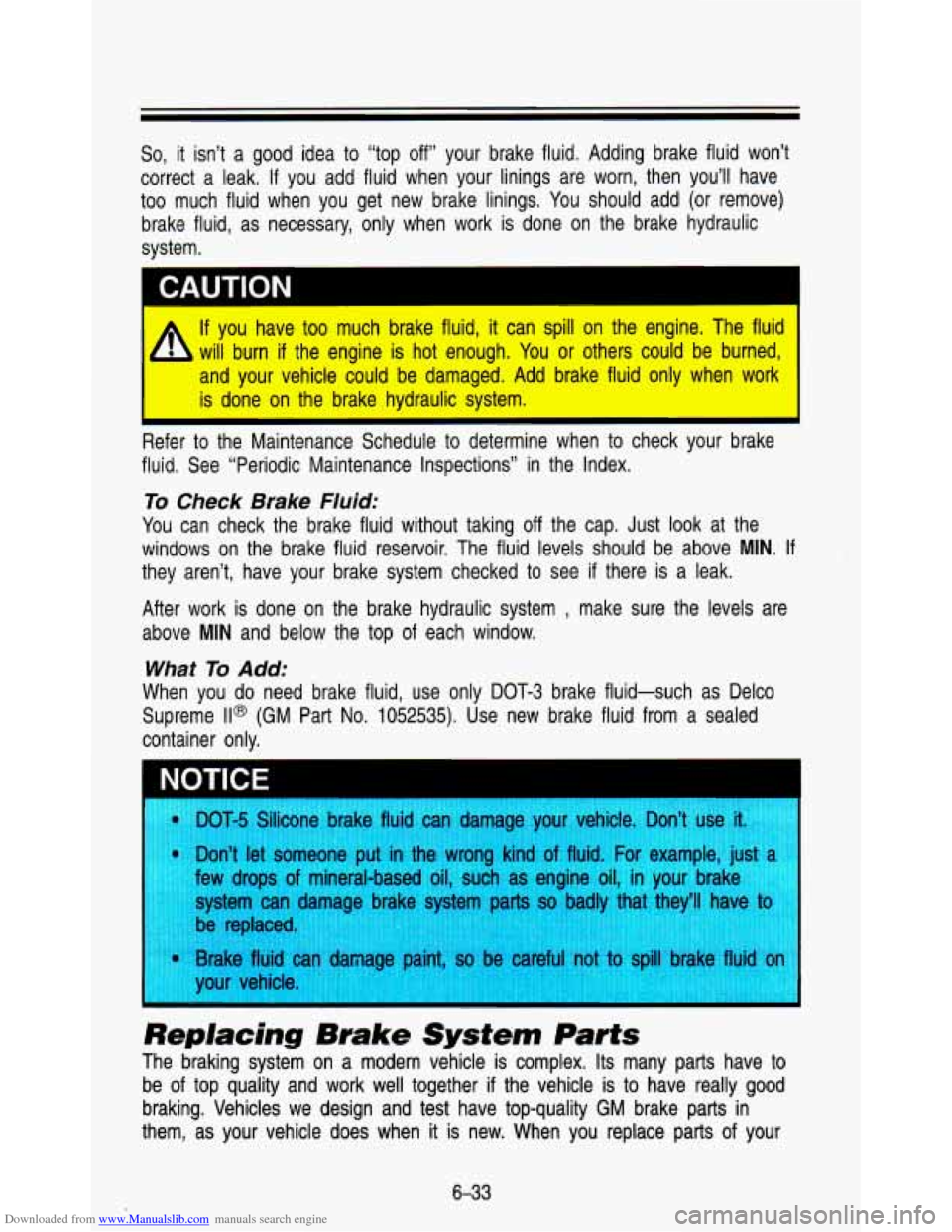
Downloaded from www.Manualslib.com manuals search engine So, it isn’t a good idea to “top off’ your brake fluid. Adding brake fluid won’t
correct a leak.
If you add fluid when your linings are worn, then you’ll have \
too much fluid when you get new brake linings. You should add (or remove)
brake fluid, as necessary, only when work is done on the brake hydraulic
system.
If you have too much brake fluid, it can spill on the engine. The fluid I
will burn if the engine is hot enough. You or others could be burned,
and your vehicle could be damaged. Add brake fluid only when work
is done on the brake hydraulic system.
I
Refer to the Maintenance Schedule to determine when to check your brake
fluid. See “Periodic Maintenance Inspections” in the Index.
To Check Brake Fluid:
You can check the brake fluid without taking off the cap. Just look at the
windows on the brake fluid reservoir. The fluid levels should be above
MIN. If
they aren’t, have your brake system checked to see if there is a leak.
After work is done on the brake hydraulic system
, make sure the levels are
above
MIN and below the top of each window.
What To Add:
When you do need brake fluid, use only DOT-3 brake fluid-such \
as Delco
Supreme
ll@ (GM Part No. 1052535), Use new brake fluid from a sealed
container only.
brake
fLlu lamagn lehicle
Replacing
Brake System Parts
The braking system on a modern vehicle is complex. Its many parts have to
be
of top quality and work well together if the vehicle is to have really good
braking. Vehicles we design and test have top-quality
GM brake parts in
them, as your vehicle does when
it is new. When you replace parts of your
6-33
Page 270 of 345
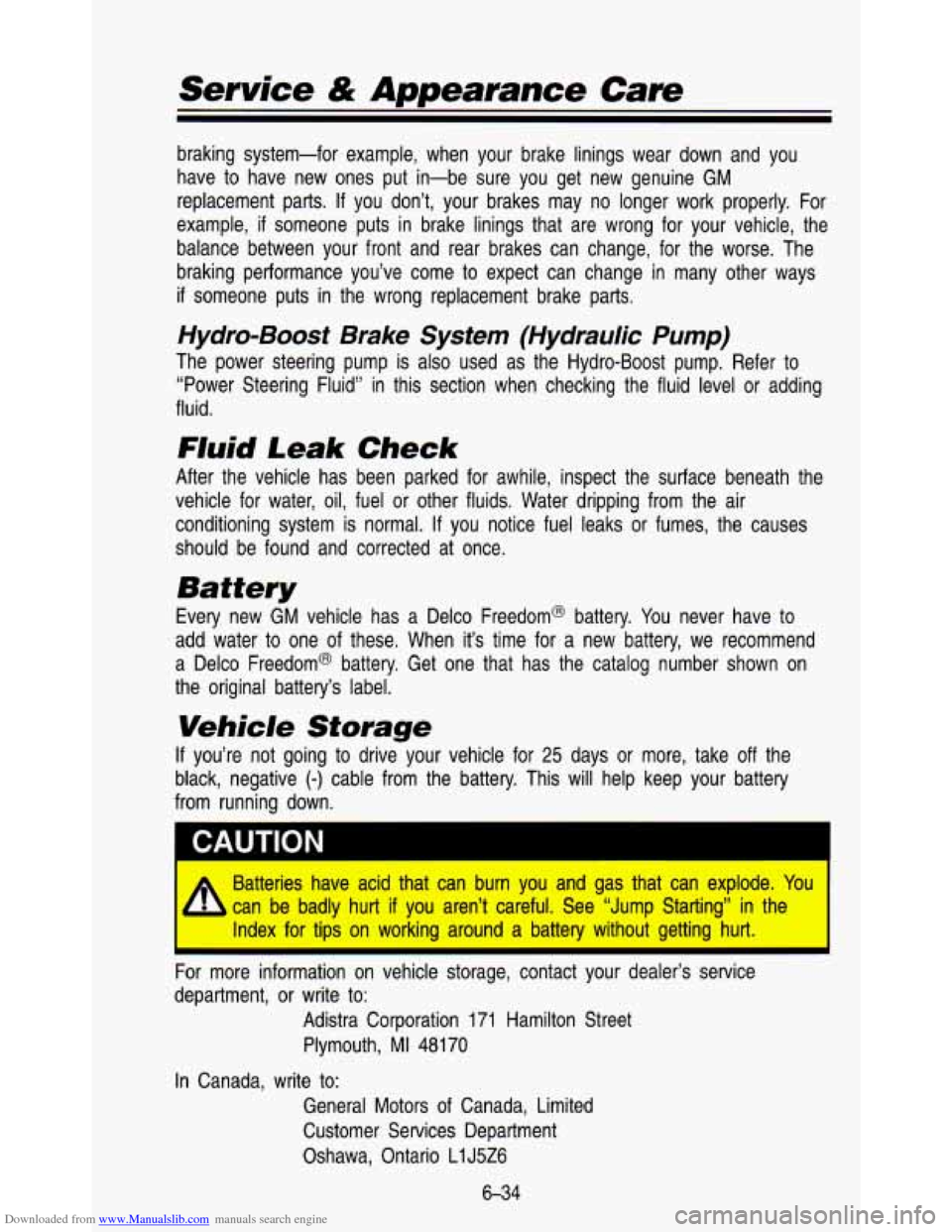
Downloaded from www.Manualslib.com manuals search engine Service & Appearance Care
braking system-for example, when your brake linings wear down and you
have
to have new ones put in-be sure you get new genuine GM
replacement parts.
If you don’t, your brakes may no longer work properly. For
example,
if someone puts in brake linings that are wrong for your vehicle, the
balance between your front and rear brakes can change, for the\
worse. The
braking performance you’ve come to expect can change in many\
other ways
if someone puts in the wrong replacement brake parts.
Hydro-Boost Brake System (Hydraulic Pump)
The power steering pump is also used as the Hydro-Boost pump. \
Refer to
“Power Steering Fluid” in this section when. checking the fluid level or adding
fluid.
Fluid Leak Check
After the vehicle has been parked for awhile, inspect the surf\
ace beneath the
vehicle for water, oil, fuel or other fluids. Water dripping f\
rom the air
conditioning system is normal. If you notice fuel leaks or fumes, the causes
should be found and corrected at once.
Battery
Every new GM vehicle has
add water
to one of these,
a Delco Freedom@ battery.
the original battery’s label. a Delco Freedom@ battery. You never have
to
When it’s time for a new battery, we recommend
Get one that has the catalog number shown on
Vehicle Storage
If you’re not going to drive your vehicle for 25 days or more, take off the
black, negative
(-) cable from the battery. This will help keep your battery
from running down.
I CAUTION
For more informarlon on vehicle storage, contact your dealer’\
s service
department, or write to:
Adistra Corporation 171 Hamilton Street Plymouth,
MI 48170
General Motors
of Canada, Limited
Customer Services Department
Oshawa, Ontario L1 J5Z6
In
Canada, write
to:
6-34
Page 314 of 345
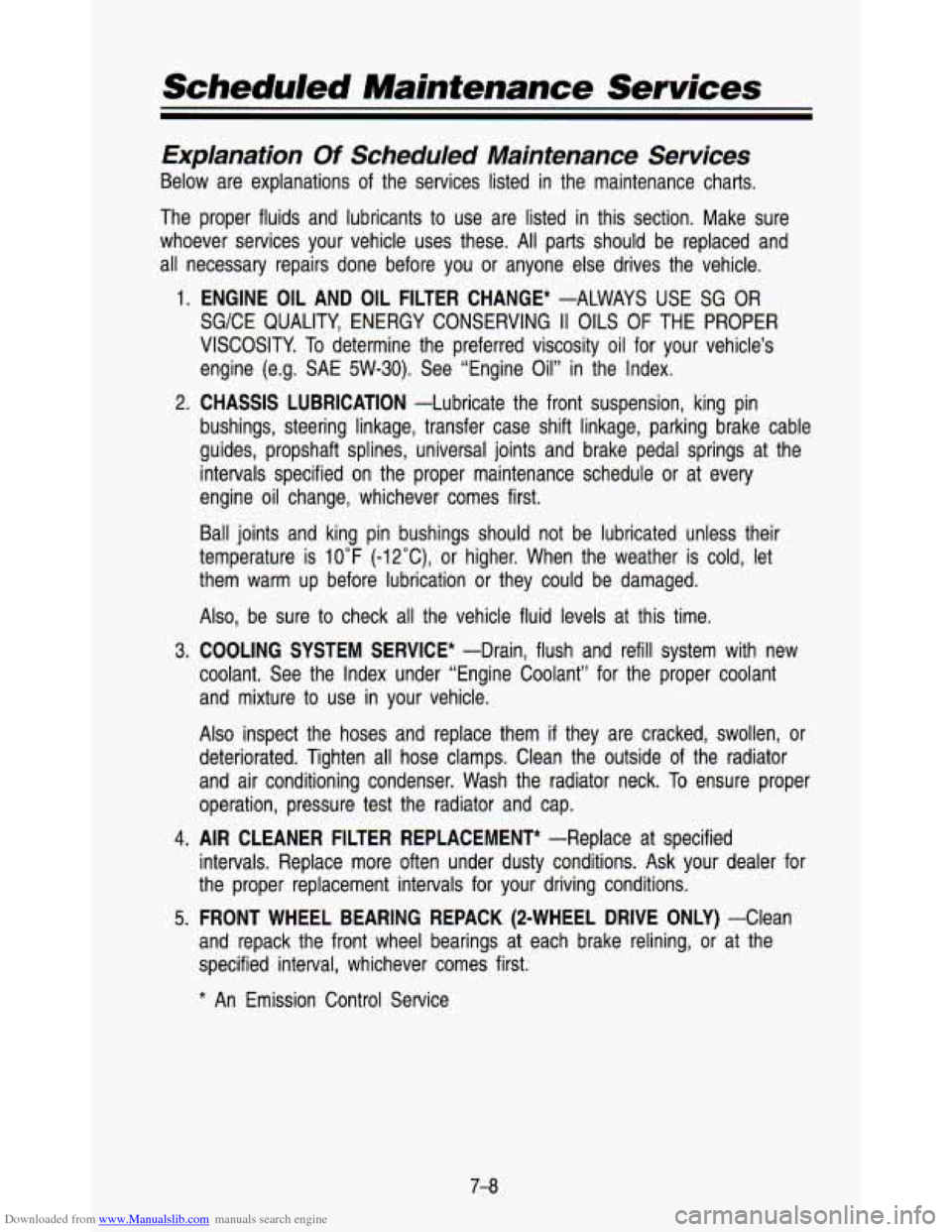
Downloaded from www.Manualslib.com manuals search engine Scheduled Maintenance Services
Explanation Of Scheduled Maintenance Services
Below are explanations of the services listed in the maintenance charts.
The proper fluids and lubricants to use are listed in this section. Make sure
whoever services your vehicle uses these. All parts should be \
replaced and
all necessary repairs done before you or anyone else drives th\
e vehicle.
1. ENGINE OIL AND OIL FILTER CHANGE* -ALWAYS USE SG OR
SG/CE QUALITY, ENERGY CONSERVING II OILS OF THE PROPER
VISCOSITY.
To determine the preferred viscosity oil for your vehicle’s
engine (e.g. SAE 5W-30). See “Engine Oil” in the Index.
bushings, steering linkage, transfer case shift linkage, parking \
brake cable
guides, propshaft splines, universal joints and brake pedal spri\
ngs at the
intervals specified on the proper maintenance schedule or at ev\
ery
engine oil change, whichever comes first.
2.
CHASSIS LUBRICATION -Lubricate the front suspension, king pin
Ball joints and king pin bushings should not be lubricated unl\
ess their
temperature is
10°F (-12”C), or higher. When the weather is cold, let
them warm up before lubrication or they could be damaged.
Also, be sure to check all the vehicle fluid levels at this time.
3.
COOLING SYSTEM SERVICE* -Drain, flush and refill system with new
coolant. See the Index under “Engine Coolant” for the pro\
per coolant and mixture to use in your vehicle.
Also inspect the hoses and replace them
if they are cracked, swollen, or
deteriorated. Tighten all hose clamps. Clean the outside of the radiator
and air conditioning condenser. Wash the radiator neck.
To ensure proper
operation, pressure test the radiator and cap.
4. AIR CLEANER FILTER REPLACEMENT* -Replace at specified
intervals. Replace more often under dusty conditions. Ask your \
dealer for
the proper replacement intervals for your driving conditions.
5. FRONT WHEEL BEARING REPACK (2-WHEEL DRIVE ONLY) -Clean
and repack the front wheel bearings at each brake relining, or at the
specified interval, whichever comes first.
* An Emission Control Service
Page 316 of 345
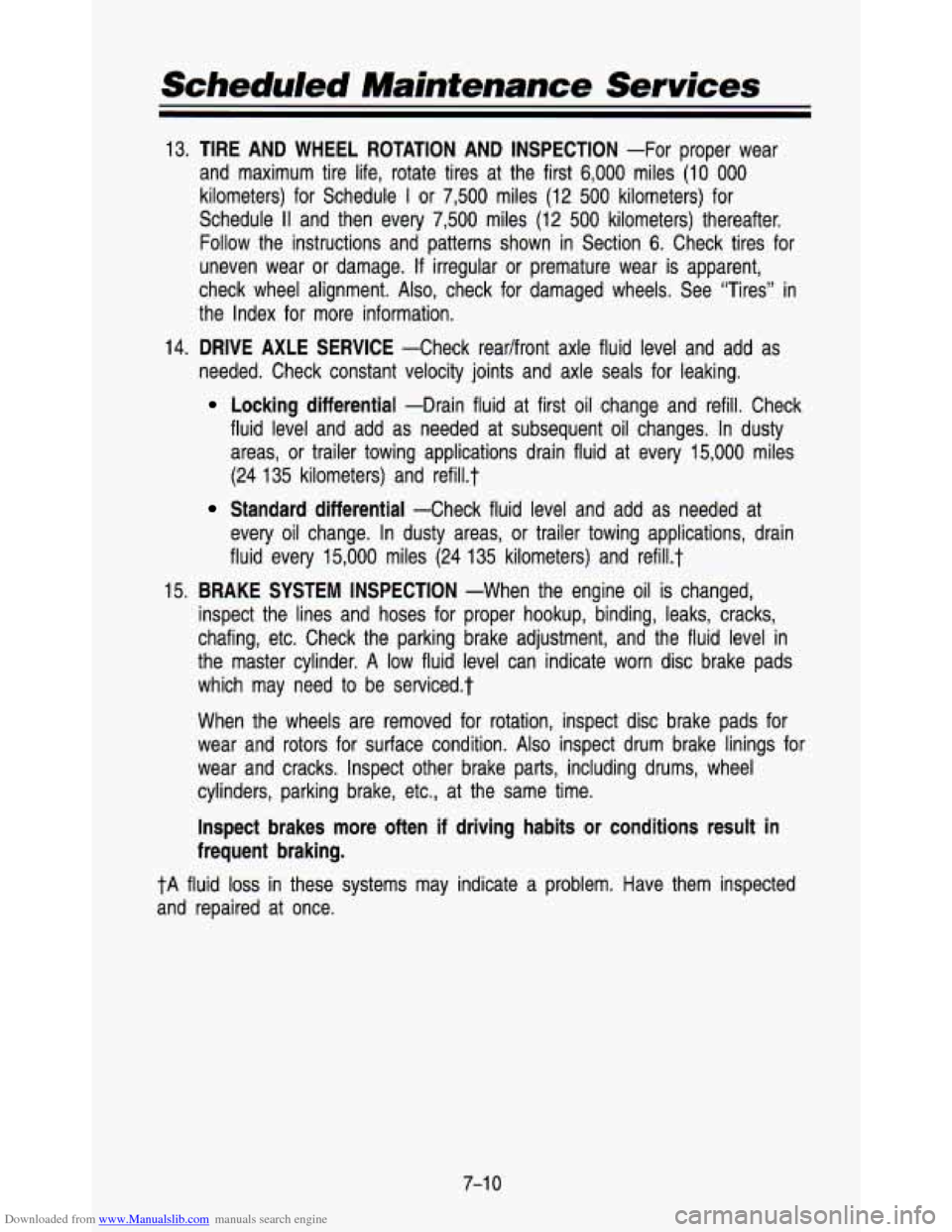
Downloaded from www.Manualslib.com manuals search engine 13. TIRE AND WHEEL ROTATION AN- INSPECTION -For proper wear
and maximum tire life, rotate tires at the first
6,000 miles (1 0 000
kilometers) for Schedule I or 7,500 miles (12 500 kilometers) for
Schedule
II and then every 7,500 miles (12 500 kilometers) thereafter.
Follow the instructions and patterns shown in Section
6. Check tires for
uneven wear or damage.
If irregular or premature wear is apparent,
check wheel alignment.
Also, check for damaged wheels. See “Tires” in
the Index for more information.
14.
DRIVE AXLE SERVICE -Check readfront axle fluid level and add as
needed. Check constant velocity joints and axle seals for leaki\
ng.
Locking differential -Drain fluid at first oil change and refill. Check
fluid level and add as needed at subsequent oil changes. In d\
usty areas, or trailer towing applications drain fluid at every 15,000 miles
(24 135 kilometers) and refi1l.t
Standard differential -Check fluid level and add as needed at
every oil change. In dusty areas, or trailer towing application\
s, drain
fluid every
15,000 miles (24 135 kilometers) and refi1l.t
15.
BRAKE SYSTEM INSPECTION -When the engine oil is changed,
inspect the lines and hoses for proper hookup, binding, leaks, \
cracks,
chafing, etc. Check the parking brake adjustment, and the fluid\
level in
the master cylinder.
A low fluid level can indicate worn disc brake pads
which may need
to be serviced$
When the wheels are removed for rotation, inspect disc brake p\
ads for
wear and rotors for surface condition.
Also inspect drum brake linings for
wear and cracks. Inspect other brake parts, including drums, wh\
eel
cylinders, parking brake, etc., at the same time.
Inspect brakes more often if driving habits or conditions result in
frequent braking.
tA fluid loss in these systems may indicate a problem. Have them inspected
and repaired at once.
7-1 0
Page 317 of 345
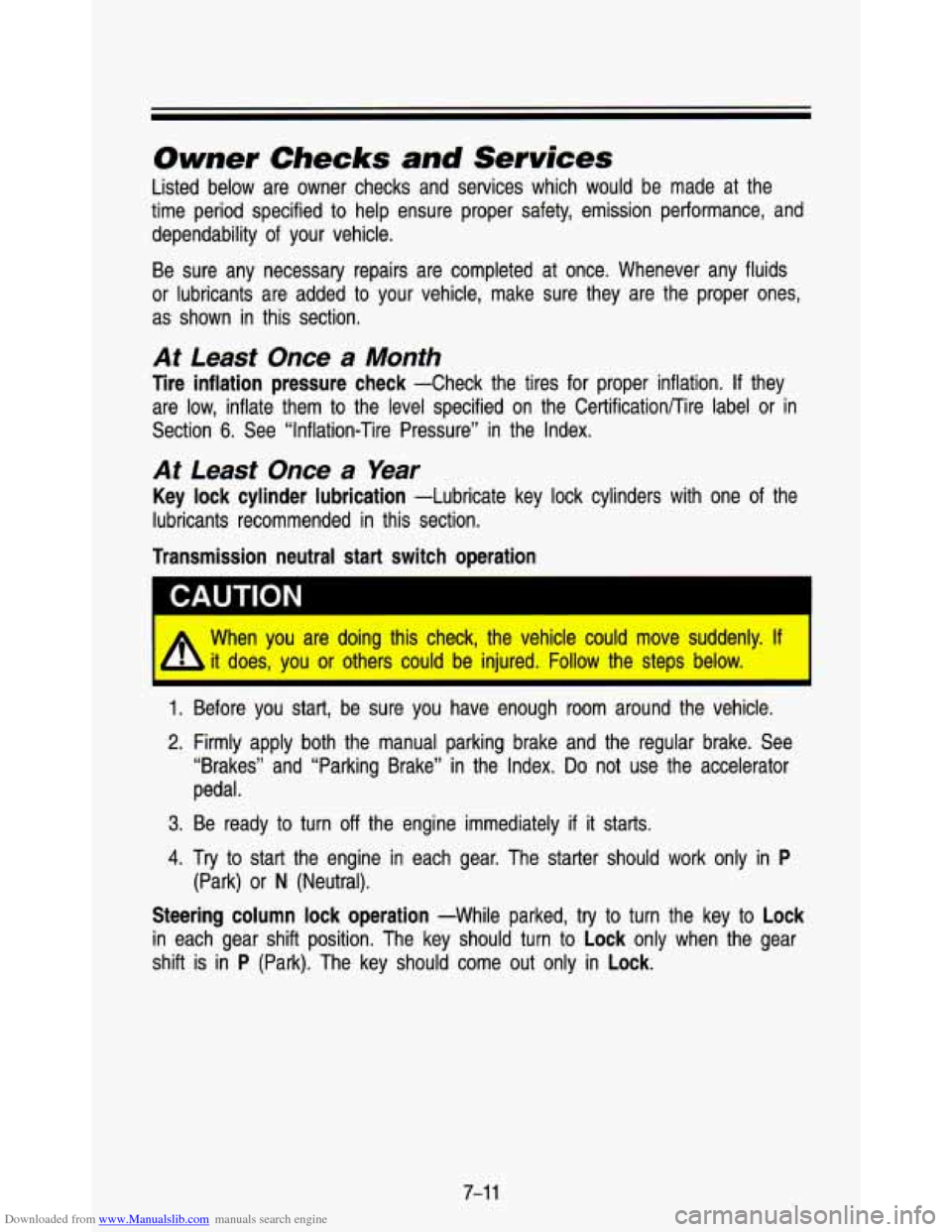
Downloaded from www.Manualslib.com manuals search engine Owner Checks and Services
Listed below are owner checks and services which would be made at the
time period specified to help ensure proper safety, emission performance, and
dependability of your vehicle.
Be sure any necessary repairs are completed at once. Whenever \
any fluids
or lubricants are added to your vehicle, make sure they are the \
proper ones,
as shown in this section.
At Least Once a Month
Tire inflation pressure check -Check the tires for proper inflation. If they
are low, inflate them
to the level specified on the CertificationRire label or in
Section
6. See “Inflation-Tire Pressure” in the Index.
At Least Once a Year
Key lock cylinder lubrication -Lubricate key lock cylinders with one of the
lubricants recommended in this section.
Transmission neutral start switch operation
I A When you are doing this check, the vehicle could move suddenly\
. If I
it does, you or others could be injured. Follow the steps below. I L
1. Before you start, be sure you have enough room around the vehicle.
2. Firmly apply both the manual parking brake and the regular brake. See
“Brakes” and “Parking Brake” in the Index.
Do not use the accelerator
pedal.
3. Be ready to turn off the engine immediately if it starts.
4. Try to start the engine in each gear. The starter should work only in P
Steering column lock operation -While parked, try to turn the key to Lock
in each gear shift position. The key should turn to Lock only when the gear
shift is in
P (Park). The key should come out only in Lock.
(Park) or N (Neutral).
7-1 1